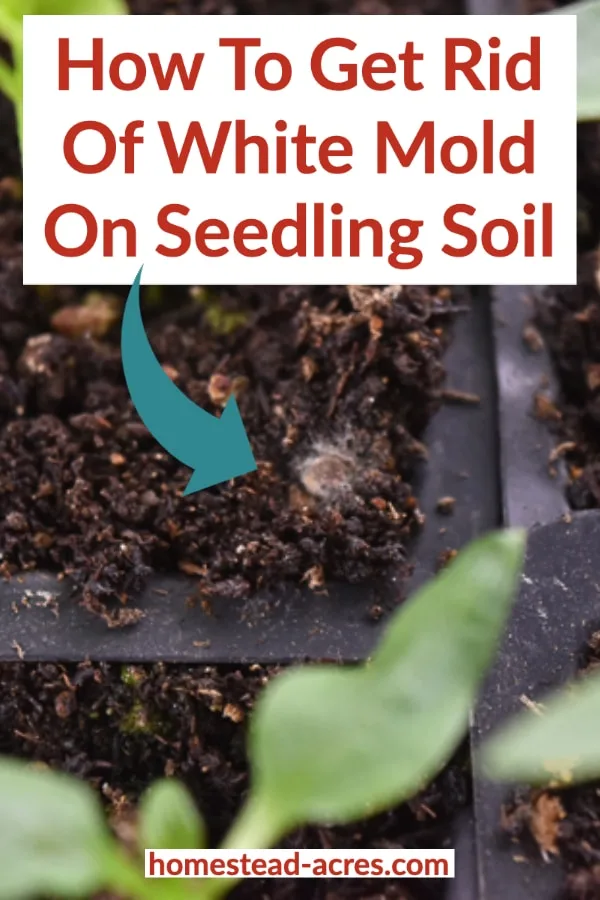This post may contain affiliate links, my full disclosure can be read here. As an Amazon Associate I earn from qualifying purchases.
Do you see a white fuzzy mold starting to grow in your seed trays? Use these tips to get rid of white mold on seed starting soil to keep your plants healthy and happy!
I love starting seeds indoors, it opens up a huge world of plants that you can’t find in a local garden center.
But it’s easy to become frustrated too, right?
But remember that seedlings are simply baby plants and they need a little more care than when they have grown up.
And a little extra work now is so worth it later when your harvest starts.

One of the most common seed starting problems is white, fluffy mold that starts to grow on the top of your seed starting row.
Does Mold In Plant Soil Hurt Seedlings?
It’s commonly thought that fuzzy white mold growing in your soil will kill seedlings but this fungus really isn’t harmful to plants.
But if you are finding mold growth happening around your seedlings then that’s a sign that conditions are right for damping off disease.
That’s a nasty problem you don’t want to have!
Damping off is caused by a type of fungus that causes your plants to pinch off and fall over quickly. But you can learn how to treat and prevent damping off.
What Causes White Mold In Seed Trays
But even though white mold is pretty harmless to plants it sure doesn’t look nice, does it? I know I don’t want mold growing in my home and I bet you don’t want it either!
It’s also a sign that something is wrong with your seed starting setup and it needs to be fixed quickly to keep your seedlings healthy.
The main causes of white mold on seed starting soil are overwatering, overcrowded seedlings, keeping them to warm and a lack of airflow.
How To Get Rid Of White Mold On Seed Starting Soil

The good news is these problems are all easily solved!
You don’t need to buy any harsh chemical sprays either, just use these simple tips to get rid of mold on your soil.
Step 1. Remove The Mold
Ok, this step is optional but it will speed things up a little bit. If you don’t want to remove the mold it’s ok because it will naturally die with the rest of the treatment.
Take a small object like a popsicle stick, pencil, or knife and gently scrape off as much of the mold from the soil as you can. Wipe it onto a paper towel or newspaper to dispose of.
You don’t have to get it all, but it does quickly make the soil look much nicer.
Step 2. Add Ventilation
If the lids are still on your seedling trays this can be a big cause of mold growth.
I always remove the lids after the seeds have sprouted as the extra humidity is really only needed during the germination stage.
If you feel that you need to keep them on because the seeds haven’t sprouted yet then try proving them open for a few hours each day to let some air in.
Simply use a long popsicle stick or twig to hold open one end of the plastic dome.
Step 3. Lower The Heat
Keeping the soil to warm can encourage mold growth and hurt your seedlings.
So while heat mats are really helpful during the germination stage, make sure to turn them off after the seedlings have started to grow.
Step 4. Proper Watering
Never let your soil become soggy or let water sit in the tray.
You do want the soil to stay consistently moist but make sure you let the top of the seed starting mix dry out before you water again.
Step 5. Natural Fungicide
Years ago I started using natural fungicides to help prevent mold and other problems in my seedlings.
The added benefit of using these is that it can be done at the same time you would water your seedlings.
There are two simple recipes that I use with great results.
The first is to use a mixture of hydrogen peroxided and water, instead of plain water when I water my seedlings.
To make this simply mix 1 teaspoon of 3% peroxide to 1 cup of water and use this to bottom water the seedlings with.
I’ve found this is a great mold preventative in our seed starting.
If you already have a mold problem or root rot then you can increase the peroxide to 1 tablespoon per 1 cup of water for treatment.
Once it’s been cleared up go back to the lower dosage.
It’s important to remember that hydrogen peroxide can harm the leaves of plants if the mixture is too strong.
Because of this, I prefer to bottom water only if using this method. Always test new treatments on a small sampling of plants to make sure you like the results.
Another natural fungicide that is easy to make is mixing 1 tablespoon of baking soda with 1 gallon of water. Then use this to water your plants.
It also works very well as a foliage spray if you have mold growing on the leaves or stems of plants. However, I don’t recommend using this mixture until after the seeds have sprouted and grown up a bit.
Prevent Mold
Use Soilless Seed Starter
One of the easiest ways to cause a mold problem with your seedlings is using a seed starter mix that has organic matter like compost or soil.
While these are both wonderful things for plants to grow in when you separate organic matter from the ground it comes out of balance with nature.
Often bagged soil mixes contain bacteria and mold spores that can start growing in your seed trays with nothing to fight it off.
Instead, use a soilless seed starting mix for starting seeds and young seedlings.
Then once they are growing well you can transplant them into larger pots with a richer compost mix.
Use Non-Organic Pots
Using natural plant pots like peat pots, coconut fiber, or even newspaper pots can seem like a good idea.
After all, we all like to use natural biodegradable products or reuse something that would go to waste.
But these types of pots are not always the best for young plants to grow in. They can stay wet for a long time and cause mold to start growing on the pot and soil.
If you find that mold is a common problem when you are starting seeds then try using plastic cell packs and pots.
If you buy good quality ones they can last for years, we have many that have been used throughout the growing season for 5 years or more.
Don’t Over Water
Avoid overwatering your seedlings, many new gardeners don’t realize that one of the main things that can kill your seedlings is overwatering.
Not only can it lead to mold growth but also to root rot and damping off disease.
Let the top of the soil dry out before watering again. Then water the seedlings well and drain off any water that remains in the seed tray after 30 minutes.
Use an organic fungicide when you water to help discourage mold growth as well.
Increase Air Flow
One of the easiest things you can do to help prevent mold growth on your seedlings is to increase air circulation.
The easiest way to do this is to set up a fan on low that can blow air through your plants.
This will help to dry the soil surface but also strengthen the stems of the seedlings too. You don’t have to leave the fan on all day.
The simplest way would be to set a timer to have it come on for about an hour or so each day.
Remember to also give space between plants under your light set so that the air can move freely through them.
Disinfect Your Seed Trays And Pots
Mold spores and plant diseases can often lay dormant in seedling trays.
To make sure your plants get the best start possible it’s always a good idea to properly clean and disinfect your seed starting trays before using them again.
Start Seeds Outdoors
I’ve always found that starting seeds indoors has more problems than when we started seeds outside or in our greenhouse.
Indoor conditions are just perfect for mold growth on wet soil. So if possible you can make things easier by starting seeds in a cold frame or greenhouse.
But don’t worry if you don’t have an outdoor growing space. Just use these tips to grow healthy seedlings indoors.
Connect With Homestead Acres!
Be sure to follow me on social media, so you never miss a post!
Facebook | Twitter | Pinterest | Twitter
Visit my Amazon store to find all my favorite gardening, homesteading tools, and gadgets plus all of my printed garden books and journals!

Kim Mills is a homeschooling mom of 6 and lives on an urban homestead in Ontario, Canada. Blogging at Homestead Acres she enjoys sharing tips to help you save money, grow and preserve your own food.


vee
Saturday 20th of May 2023
Just a small note: You wrote: Keeping the soil to warm …..it should be, Keeping the soil TOO warm. I’m sure it was just an over sight!
Greg
Wednesday 8th of March 2023
I started vegatable seeds in CowPots, with forest derived compost/dirt. The seedlings sprouted but so did little mushrooms all over the place, even on the outside of the pots.
After reading here, I made a mistake. But my question is, do I have to throw them all away now?
Rayba
Wednesday 22nd of March 2023
@Greg, I'm no expert, but from what I've heard mushrooms growing with your plant is a good thing as they usually live a symbiotic relationship. if it grosses you out you can pick the mushrooms off as they are only the "fruits" of the actual mushroom plant
Rebecca
Sunday 1st of May 2022
Hi! I’ve just had some Brussels sprouts and cucumber come through the soil and some have the fuzzy mold. Are these seedlings still safe to eat later on if the mold problem is resolved?
Adrian
Thursday 25th of November 2021
Hey Kim,
I’m growing succulents from seed in small, 12 cell mini “greenhouses”, and am experiencing white mold on the surface of the substrate. I’m using a mix of vermiculite, fine and slightly coarse sand. What should the water level be in the bottom/under trays? I literally just removed the domes, albeit a bit late as the succulents germinated a few weeks ago. I’ve been keeping the water level so the bottoms of the cells are slightly submerged. Any info you have would be greatly appreciated!
Yours Truly, Adrian
Chenille
Thursday 13th of May 2021
This is very helpful, thank-you!!